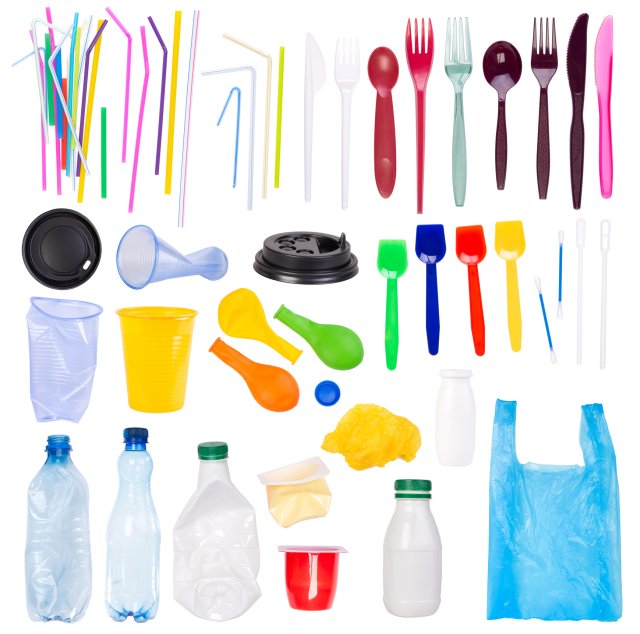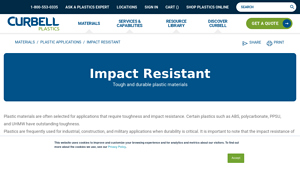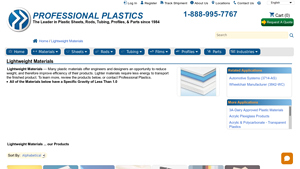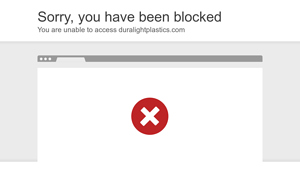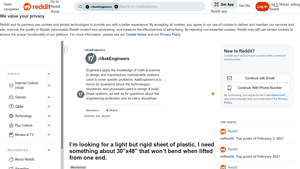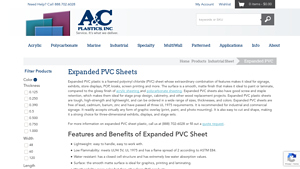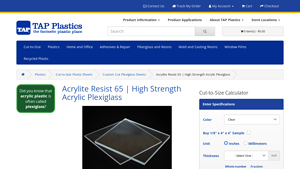Lightweight Strong Plastic Guide: Type, Cost, Top List…
Introduction: Navigating the Global Market for lightweight strong plastic
Understanding the intricacies of sourcing lightweight strong plastics in today’s global marketplace can pose significant challenges for B2B buyers, especially in regions like Africa, South America, the Middle East, and Europe. With diverse applications ranging from aerospace to consumer goods, the demand for high-performance, durable materials is escalating. This guide is tailored to demystify the wide array of lightweight strong plastics available, including materials like PEEK, polycarbonate, and nylon, while highlighting their unique properties and optimal applications.
In this comprehensive resource, we delve into critical aspects including material types, their mechanical and thermal properties, industry-specific applications, and practical tips for vetting potential suppliers. Additionally, we explore the cost implications and sourcing strategies necessary for making informed purchasing decisions. As the global landscape continues to evolve, leveraging this guide empowers international B2B buyers to navigate the complexities of the market confidently, ensuring they select the right materials that meet their operational needs while adhering to local and international standards.
By providing actionable insights and expert guidance, we aim to equip stakeholders with the knowledge necessary to harness the potential of lightweight strong plastics, ultimately driving innovation and efficiency in their operations. Whether you’re in Nigeria, Brazil, or any other corner of the globe, this essential guide serves as your roadmap to successful material sourcing and application.
Understanding lightweight strong plastic Types and Variations
| Type Name | Key Distinguishing Features | Primary B2B Applications | Brief Pros & Cons for Buyers |
|---|---|---|---|
| Polycarbonate | High impact resistance, clarity | Aerospace, automotive, electronics | Pros: Outstanding strength, lightweight, good for visibility. Cons: Prone to scratching unless treated. |
| Nylon (PA) | High strength, wear resistance | Mechanical parts, textiles | Pros: Versatile, chemical resistant, good elasticity. Cons: High moisture absorption can affect properties. |
| Polyetheretherketone (PEEK) | Exceptional thermal stability and rigidity | Aerospace, medical devices, automotive | Pros: Excellent fatigue resistance, durability under stress. Cons: High cost limits wider use. |
| Polyphenylene Sulfide (PPS) | High heat resistance and chemical stability | Aerospace, electronics, automotive | Pros: Great for harsh environments, strong chemical resistance. Cons: Limited toughness; requires precise processing. |
| High-Density Polyethylene (HDPE) | Durable, low cost, chemical resistant | Packaging, automotive, construction | Pros: Affordable, versatile, good impact resistance. Cons: Lower temperature tolerance compared to engineering plastics. |
What Are the Characteristics of Polycarbonate in B2B Applications?
Polycarbonate is highly valued for its clarity and exceptional impact resistance, making it ideal for applications requiring transparency and durability, such as in aircraft canopies and electronic devices. Its lightweight nature enhances fuel efficiency in automotive segments. When purchasing polycarbonate products, B2B buyers should consider treatments for scratches or UV exposure to maintain performance and aesthetics.
How Does Nylon (PA) Perform as a Durable Plastic?
Nylon, particularly variants like Nylon 66, is recognized for its superior strength and wear resistance, making it suitable for mechanical components like gears, bearings, and textiles. Its good chemical resistance allows it to be used in harsh environments. Buyers need to be aware of its water absorption properties, which might affect the material’s performance in humid conditions, necessitating appropriate applications.
What Makes Polyetheretherketone (PEEK) Stand Out?
PEEK is an engineering thermoplastic known for its robust stiffness, outstanding chemical resistance, and high thermal stability. Frequently utilized in the aerospace and medical sectors, PEEK is ideal for applications exposed to extreme conditions. B2B buyers should weigh its high cost against its long-term performance benefits, particularly in demanding environments that require reliable materials.
Why Consider Polyphenylene Sulfide (PPS) for Your Industrial Needs?
PPS excels in high-temperature and chemically aggressive environments, making it invaluable in aerospace, electronics, and automotive applications. Its thermal stability allows for prolonged use in conditions exceeding 200°C, but buyers need to consider its toughness constraints and the technical expertise needed for proper processing.
Is High-Density Polyethylene (HDPE) a Cost-Effective Choice?
HDPE is a versatile and durable plastic known for its affordability and resistance to chemicals and impact. It’s commonly used in packaging, automotive applications, and construction. While it offers excellent mechanical properties at a low cost, B2B buyers should keep in mind its limited heat resistance compared to engineering plastics, particularly for high-performance applications.
Key Industrial Applications of lightweight strong plastic
| Industry/Sector | Specific Application of Lightweight Strong Plastic | Value/Benefit for the Business | Key Sourcing Considerations for this Application |
|---|---|---|---|
| Aerospace | Lightweight structural components for aircraft | Reduces fuel consumption and increases payload capacity | Regulatory compliance, high-performance specifications |
| Automotive | Engine components and interior parts | Enhances vehicle efficiency and safety | Temperature resistance, durability under stress |
| Medical Devices | Surgical instruments and implants | Ensures sterility, strength, and reduced weight | Biocompatibility, chemical resistance, customization options |
| Electronics | Insulating housings and casings | Enhances durability and protects sensitive components | Electrical properties, thermal stability, sourcing reliability |
| Construction | Crash-resistant panels and façade materials | Increases safety and aesthetic appeal | Weather resistance, impact strength, local availability |
How Is Lightweight Strong Plastic Used in Aerospace Applications?
In the aerospace sector, lightweight strong plastics are integral for manufacturing structural components, including panels and frames. These materials contribute to significant weight reduction, leading to improved fuel efficiency and greater payload capacity. Buyers in this sector must prioritize compliance with strict aviation regulations while considering the mechanical properties crucial for ensuring safety and performance in flight.
What Are the Benefits of Lightweight Strong Plastic in Automotive Manufacturing?
The automotive industry employs lightweight strong plastics for various engine components and interior elements to enhance vehicle efficiency. By utilizing these plastics, manufacturers can decrease overall weight, leading to improved fuel economy and emissions reductions. Buyers must focus on materials that offer high thermal stability and resistance to environmental stressors to ensure long-term reliability in diverse operating conditions.
In What Ways Does Lightweight Strong Plastic Contribute to Medical Devices?
In medical applications, lightweight strong plastics are critical for designing surgical instruments and implants. These materials provide the necessary strength and durability while being lighter than traditional metals, which improves surgical handling. Moreover, compatibility with sterilization processes and resistance to chemicals are essential when sourcing these materials, as they ensure compliance with health regulations and safety standards.
How Is Lightweight Strong Plastic Employed in Electronics?
In the electronics industry, lightweight strong plastics are commonly used to manufacture insulating housings and protective casings for sensitive electronics. These plastics protect components from environmental hazards while enhancing overall durability. For B2B buyers in this sector, it’s essential to consider the thermal stability and electrical properties of the materials, ensuring they meet industry-specific performance standards.
What Role Does Lightweight Strong Plastic Play in Construction?
Within the construction industry, lightweight strong plastics serve as crash-resistant panels and façade materials, combining safety with aesthetic appeal. They can withstand harsh weather conditions while providing added protection and insulation. For international buyers, sourcing should focus on weather resistance and impact strength to ensure materials are tailored to meet regional demands and building regulations.
3 Common User Pain Points for ‘lightweight strong plastic’ & Their Solutions
Scenario 1: Ensuring Durability in Harsh Environments
The Problem:
B2B buyers need lightweight, strong plastic materials for applications in challenging environments, such as outdoor or industrial settings. They often face the challenge of selecting the right material that can withstand extreme temperatures, humidity, and chemical exposure without degrading. For example, materials deployed in the aerospace or automotive industries must endure vibrations and fluctuating temperatures while maintaining structural integrity. If the material fails, it can lead to catastrophic failures, loss of revenue, and damage to reputation.
The Solution:
To overcome these challenges, buyers should prioritize sourcing high-performance polymers such as Polyetheretherketone (PEEK) or Polyphenylene Sulfide (PPS). Both materials offer exceptional thermal stability and chemical resistance, making them ideal for demanding applications. It’s essential to collaborate closely with suppliers to understand the specific requirements of your application. Buyers should specify requirements clearly, including expected temperatures, environmental conditions, and mechanical stresses. By working with experts in material properties, companies can ensure they select the right grade and process the materials properly for their intended applications.
Scenario 2: Balancing Costs and Performance
The Problem:
In a competitive market, many B2B buyers wrestle with the dual challenge of meeting performance specifications while keeping production costs under control. Lightweight strong plastics, such as Nylon and Polyoxymethylene (POM), provide high strength and durability but can sometimes command higher prices compared to traditional materials. This predicament can lead to difficult compromises between quality and cost, forcing businesses to choose between performance and budget.
The Solution:
To navigate this cost-performance dilemma, buyers should conduct a thorough cost-benefit analysis that considers the overall lifecycle of the material, not just initial costs. Invest time in exploring alternative materials that may not be on the immediate radar, like High-Impact Polystyrene or Polycarbonate, which offer a balance of performance and cost-efficiency. Establish long-term relationships with reliable suppliers who can provide bulk discounts or flexible pricing options based on volume commitments. Additionally, organizations can consider engaging in collaborative partnerships with suppliers for joint development projects that could lead to tailored materials specifically designed for their needs, optimizing both performance and budget.
Scenario 3: Ensuring Consistency in Quality Standards
The Problem:
Quality control is a critical concern for B2B buyers of lightweight strong plastics, especially in industries like medical devices or aerospace, where regulatory compliance and product reliability are paramount. Inconsistent material quality can lead to failures that not only affect product performance but also pose safety risks, resulting in costly recalls and regulatory penalties. Buyers often struggle to verify that the materials they source meet exacting standards consistently.
The Solution:
To ensure consistent quality, it’s important for buyers to establish comprehensive quality assurance protocols with their suppliers. This includes requiring suppliers to provide certifications for material properties, detailing testing methods, and ensuring compliance with relevant industry standards (e.g., ISO or ASTM). Moreover, buyers should implement a robust inspection process upon receiving materials, incorporating both in-house testing where feasible and third-party evaluations. Creating a feedback loop with suppliers can enhance product development and align quality expectations. By making quality a mutual concern, companies can foster more transparent relationships that help uphold standards and reduce variability in incoming materials.
Strategic Material Selection Guide for lightweight strong plastic
When evaluating the strategic material selection for lightweight strong plastics, it’s crucial to understand the specific properties and applications of various materials that cater to industrial needs and compliance requirements across regions. Here are analyses of three high-performance materials often utilized in B2B applications for lightweight, strong plastics.
Which Lightweight Strong Plastics Are Most Suitable for B2B Applications?
Polycarbonate: A Versatile Heavyweight in Lightweight Plastics
Key Properties: Polycarbonate is renowned for its unparalleled impact resistance, boasting a high temperature and pressure rating. It exhibits excellent dimensional stability, making it a reliable choice for various applications.
Pros & Cons: This material is durable and lightweight, lending itself well to applications in industries ranging from automotive to aerospace. However, polycarbonate can be sensitive to UV light exposure unless additives are incorporated, which may add to the cost. Its relatively easier machining process is an advantage, though it may require specific handling to avoid scratching.
Impact on Application: Polycarbonate is especially suited for applications requiring transparency combined with high strength, such as protective shields or safety glasses. Its high-impact resistance allows it to withstand harsh environmental conditions.
International Considerations: Buyers, particularly in Africa, South America, and the Middle East, should ensure compliance with material standards such as ASTM (American Society for Testing and Materials). Markets in Europe may prefer certifications like CE marking, emphasizing safety and performance.
Nylon (Polyamide): The Tough Workhorse
Key Properties: Nylon exhibits a high strength-to-weight ratio, excellent wear resistance, and good elasticity. It can tolerate significant loads, making it ideal for mechanical components.
Pros & Cons: While it offers outstanding performance for applications like gears, bearings, and automotive parts, nylon is hydrophilic. It absorbs moisture, which can lead to degradation in humid environments. Its versatility is balanced by potential limitations in high-temperature resistance.
Impact on Application: In regions with fluctuating humidity, such as parts of South America and Africa, careful consideration regarding the moisture environment is critical. Manufacturers should assess how nylon’s properties align with their specific needs, especially for components where dimensional stability is paramount.
International Considerations: Compliance with JIS (Japanese Industrial Standards) and ISO standards is essential when sourcing nylon components. B2B buyers should also look to ensure availability of specific grades that fulfill local requirements.
PEEK (Polyetheretherketone): The High-Performance Choice
Key Properties: PEEK is known for its remarkable mechanical strength and thermal stability, functioning in extreme temperatures (up to 250°C) without losing its structural integrity. It also offers strong chemical resistance.
Pros & Cons: While its exceptional performance makes it ideal for advanced applications in aerospace and medical devices, PEEK comes with a high price tag. Its processing complexity and stringent manufacturing requirements may lead to increased production costs, limiting its application primarily to specialty sectors.
Impact on Application: PEEK is suitable for harsh environments, making it popular in high-performance contexts. Industries utilizing PEEK are often those requiring advanced materials that can withstand demanding conditions, ensuring reliability and longevity.
International Considerations: B2B buyers should be aware that PEEK must often meet stringent compliance standards, including those set by ASTM and UL certifications. International buyers should check for regional supply chains to ensure timely delivery and reduced costs.
Summary Table of Lightweight Strong Plastics
| Material | Typical Use Case for lightweight strong plastic | Key Advantage | Key Disadvantage/Limitation | Relative Cost (Low/Med/High) |
|---|---|---|---|---|
| Polycarbonate | Protective eyewear, safety shields | Excellent impact resistance | Sensitive to UV exposure | Medium |
| Nylon | Gears, automotive parts | High strength-to-weight ratio | Absorbs moisture, limited temperature resistance | Medium |
| PEEK | Aerospace components, medical devices | Exceptional thermal and chemical resistance | High cost and complex manufacturing | High |
This strategic material selection guide serves as a comprehensive resource for B2B buyers aiming to make informed decisions regarding lightweight strong plastics that suit their specific applications and regional compliance requirements.
In-depth Look: Manufacturing Processes and Quality Assurance for lightweight strong plastic
What Are the Key Stages in the Manufacturing Process of Lightweight Strong Plastics?
The manufacturing of lightweight strong plastics is a multi-stage process designed to ensure high quality and performance. Each stage plays a critical role in the final product’s characteristics. Here’s a breakdown of the main stages involved:
1. Material Preparation
Material preparation is the foundation for producing lightweight strong plastics. Depending on the selected polymer — such as polycarbonate, polyetheretherketone (PEEK), or nylon — raw materials are sourced in the required forms, like pellets or sheets. This stage may involve:
- Drying: Certain plastics absorb moisture, impacting their performance. Drying is critical to avoid defects.
- Mixing: Additives and colorants are blended with the base material to enhance properties or achieve desired aesthetics.
- Pre-conditioning: Some materials are pre-conditioned to specific temperatures or atmospheres, which helps in subsequent processing.
The quality of raw materials directly affects the performance of the final product, making this stage vital for B2B buyers who require reliability in functionality.
2. Forming Techniques for Lightweight Strong Plastics
Once the materials are prepared, various forming techniques are employed to shape the plastics according to specifications. Common methods include:
-
Injection Molding: This is perhaps the most widely used technique for creating complex shapes. Material is heated until molten and injected into a mold where it cools and solidifies. This method is ideal for mass production and ensures high precision.
-
Extrusion: Employed for continuous shapes like tubes or sheets, the material is forced through a die. This process is often used for creating components that are later cut to size.
-
Thermoforming: In this technique, sheets of plastic are heated to a pliable state and then formed over a mold. This is particularly useful for larger components that do not require stiffening.
-
3D Printing: Increasingly popular in custom manufacturing, this additive process builds parts layer by layer. It is valuable for rapid prototyping and small-batch production.
Understanding these techniques empowers B2B buyers to choose the right process for their needs based on the desired end-use application.
3. Assembly of Lightweight Strong Plastic Products
After forming, the next phase may involve assembly, depending on the complexity of the product. Components manufactured separately may be combined into a final assembly through methods such as:
- Adhesive Bonding: Solvent-based or structural adhesives create robust joints that can withstand stress.
- Mechanical Fastening: Screws, rivets, or snap-fit designs ensure components remain securely fastened, which is critical in high-stress applications.
- Welding: Certain plastic types can be welded to create a permanent bond, achieving structural integrity.
Effective assembly techniques are crucial for enhancing product performance and ensuring longevity, critical factors for B2B buyers in demanding industries.
4. Finishing Processes to Enhance Product Quality
Finishing processes refine the product’s surface and prepare it for end use. These processes can include:
- Machining: Cutting or milling to achieve tight tolerances or specific surface finish requirements.
- Coating: Applying surface treatments to enhance barrier properties, durability, or aesthetics. This may include paints or protective films.
- Polishing: High-gloss finishes can be achieved through polishing, particularly in consumer-facing products.
For international B2B buyers, understanding these finishing touches can influence product quality and market acceptance.
What Are the International Quality Assurance Standards for Lightweight Strong Plastics?
Quality assurance (QA) is essential in the manufacturing of lightweight strong plastics, ensuring that products meet international and industry-specific standards.
1. Relevant International Standards
-
ISO 9001: This widely recognized standard focuses on quality management systems. Achieving ISO 9001 certification demonstrates a company’s commitment to quality, customer satisfaction, and continuous improvement, which is beneficial for B2B buyers looking for reliable suppliers.
-
CE Marking: Required in the European Union, CE marking indicates that a product meets safety, health, and environmental protection standards. For companies exporting to Europe, CE certification can simplify market entry.
-
API Specification: For buyers in the oil and gas industry, API specifications set strict requirements around materials and safety, crucial when sourcing components like pumps or valves.
2. Key Quality Control Checkpoints
Quality control is structured around several key checkpoints during the manufacturing process:
-
Incoming Quality Control (IQC): This initial stage involves inspecting raw materials upon arrival to confirm compliance with specifications before production begins.
-
In-Process Quality Control (IPQC): Continuous monitoring during the manufacturing process helps identify issues early, minimizing waste and rework.
-
Final Quality Control (FQC): Conducted on completed products, FQC verifies that the final products meet all design and functionality criteria.
How Can B2B Buyers Verify Supplier Quality Control?
Verification of supplier quality control processes is crucial for B2B buyers looking for reliable partners. Here are some effective strategies:
1. Conduct Supplier Audits
On-site audits can provide invaluable insights into a supplier’s manufacturing processes and quality assurance systems. Look for:
- Certifications and compliance with international standards.
- Documentation of quality processes and previous audits.
- Evidence of how defects are managed and rectified.
2. Request Quality Reports
Suppliers should provide detailed reports on their quality assurance practices, including data from IQC, IPQC, and FQC phases. Buyers should look for consistency in passing rates, testing outcomes, and supplier responsiveness to non-conformities.
3. Use Third-Party Inspection Services
Engaging third-party inspection firms can help ensure impartial assessments. These services often include material testing, compliance checks, and factory audits, offering an added layer of assurance to B2B buyers.
What Are the Quality Control Nuances for International B2B Buyers?
International buyers from diverse regions such as Africa, South America, the Middle East, and Europe face unique challenges regarding quality control and supplier relationships. Here’s how to navigate them:
-
Cultural Differences: Understanding local business practices and cultural nuances can facilitate better communication and collaboration with suppliers.
-
Regulatory Compliance: Each region may have specific regulations impacting product safety and import/export processes. B2B buyers must ensure that suppliers are compliant with both local and international regulations, requiring thorough documentation.
-
Risk Assessment: Conducting comprehensive risk assessments and contingency planning is crucial to mitigate potential supply chain disruptions or quality issues.
In summary, navigating the manufacturing and quality assurance landscape for lightweight strong plastics involves understanding diverse processes, standards, and verification strategies. B2B buyers equipped with this knowledge can make informed decisions that align with their quality requirements and market expectations.
Practical Sourcing Guide: A Step-by-Step Checklist for ‘lightweight strong plastic’
Introduction
In the competitive landscape of international B2B sourcing, procuring lightweight strong plastic is a strategic endeavor that requires careful consideration. This guide aims to equip buyers with a structured checklist to facilitate informed decisions while ensuring quality and cost-effectiveness.
Step 1: Define Your Technical Specifications
Before engaging with suppliers, clarify the technical requirements for the lightweight strong plastic you need. This includes determining factors such as tensile strength, impact resistance, thermal stability, and chemical resistance.
– Identify the specific application your material will be used for, such as automotive parts or consumer goods.
– Consider temperature ranges, environmental exposure, and regulatory compliance relevant to your industry.
Step 2: Evaluate Material Options
Select the types of lightweight strong plastics that match your technical specifications. Popular options include polycarbonate, nylon, and PEEK, each offering unique benefits for different applications.
– Review their mechanical properties, such as rigidity and wear resistance.
– Assess their suitability for your manufacturing processes—some materials may require specialized equipment or techniques.
Step 3: Conduct a Supplier Market Analysis
Research potential suppliers, focusing on their reputation, capabilities, and product offerings. Understanding market dynamics can reveal industry leaders and emerging players.
– Use trade directories, online platforms, and industry publications to compile a list.
– Analyze market reviews and testimonials to gauge supplier reliability and customer service.
Step 4: Verify Supplier Certifications
Ensure that potential suppliers have the necessary certifications that demonstrate compliance with international quality standards, such as ISO 9001 or ASTM.
– Certifications provide assurance of quality control processes and material properties.
– Don’t hesitate to ask for documentation and reports to confirm their validity.
Step 5: Request Samples for Testing
Before finalizing any orders, request material samples for rigorous testing. This key step enables you to evaluate the performance of the plastic in your intended application.
– Assess the samples against your defined specifications, focusing on performance under stress and durability.
– Involve your engineering team to conduct thorough evaluations and ensure the materials meet your standards.
Step 6: Negotiate Terms and Pricing
Once you’ve identified a supplier that meets your needs, engage in negotiations to establish favorable terms. This may include pricing, delivery timelines, and payment terms.
– Compare quotes from multiple suppliers to ensure competitiveness.
– Discuss bulk order discounts and flexible terms that can facilitate long-term partnerships.
Step 7: Establish a Quality Assurance Process
Develop a quality assurance plan to monitor and verify the performance of the materials throughout the supply chain. Maintaining quality control is crucial to ensuring compliance and satisfaction.
– Outline inspection protocols, acceptance criteria, and documentation requirements for incoming materials.
– Ensure that your team is prepared to handle any discrepancies in quality effectively.
By following this structured checklist, B2B buyers can make informed sourcing decisions that align with their operational needs and business objectives, ensuring a successful procurement of lightweight strong plastics.
Comprehensive Cost and Pricing Analysis for lightweight strong plastic Sourcing
Understanding the B2B cost structure and pricing for lightweight strong plastics is essential for international buyers looking to make informed sourcing decisions. This analysis covers key cost components, price influencers, and offers practical tips for buyers navigating the global marketplace.
What are the Key Cost Components in Lightweight Strong Plastics?
The cost structure for lightweight strong plastics consists of several critical components:
-
Materials: The choice of raw materials plays a significant role in the overall cost. Resins such as Polycarbonate, Nylon, and PEEK are popular for their strength-to-weight ratios, but materials like ABS and HDPE can be more budget-friendly options. The price of these materials fluctuates based on market demand and supply chain conditions.
-
Labor: Production costs are heavily influenced by labor rates, which can vary widely depending on the manufacturing location. Countries with lower labor costs may provide advantages in pricing, while highly skilled labor in regions with advanced manufacturing techniques may drive up costs.
-
Manufacturing Overhead: This includes facility costs, utility expenses, and equipment maintenance. Efficient operations can minimize overhead, making it a crucial factor for manufacturers striving to offer competitive pricing.
-
Tooling: Investment in molds, dies, and specialized tools necessary for production can represent a significant upfront cost. High-quality tooling often results in better product quality and longevity, impacting the overall cost structure.
-
Quality Control (QC): Ensuring that products meet quality standards incurs additional costs. This includes testing for impact resistance, chemical stability, and conformity to specifications, which is especially important in regulated industries.
-
Logistics: Shipping and handling costs can vary significantly based on the supplier’s location and shipping terms. This includes freight, insurance, and handling fees, and can be a decisive factor for buyers in regions like Africa and South America.
-
Margin: Suppliers often add a profit margin to their costs, which can vary based on market competition and demand elasticity. Understanding typical margins in the industry can help buyers anticipate final pricing.
What Influences the Pricing of Lightweight Strong Plastics?
Several factors influence pricing beyond the raw cost structure:
-
Volume and Minimum Order Quantity (MOQ): Larger orders typically yield lower per-unit prices due to economies of scale. Buyers should negotiate MOQ to secure better pricing, especially when forecasting long-term needs.
-
Specifications and Customization: Tailoring products to specific requirements, whether through unique formulations or custom dimensions, increases costs. Clear communication of specifications can streamline the quoting process and reduce misunderstandings.
-
Material Quality and Certifications: High-quality materials with relevant certifications (such as ISO or ASTM) command premium prices, providing assurances of performance and safety. Buyers must weigh the cost versus benefits of certified materials.
-
Supplier Reliability and Relationship: Well-established suppliers with a history of quality and reliability may charge more for their products. Building long-term relationships can often lead to better pricing and service.
-
Incoterms: Understanding shipping terms is crucial in assessing total costs. Terms like CIF (Cost, Insurance, Freight) versus FOB (Free on Board) can significantly affect landed costs and should be carefully negotiated.
What Tips Can Help Buyers Optimize Their Sourcing?
International buyers can enhance their sourcing strategies through strategic negotiation and consideration of total cost ownership:
-
Negotiate Pricing: Use market research and competitor pricing data to negotiate better rates. Cultivating multiple quotes can provide leverage in discussions.
-
Evaluate Total Cost of Ownership (TCO): Look beyond initial procurement costs. Consider lifecycle costs, which include maintenance, disposal, and transport. A seemingly higher-priced item may offer better durability, leading to lower overall costs.
-
Understand Pricing Nuances for International Purchases: Currency fluctuations and trade tariffs can impact pricing for global buyers. Staying informed on trade policies relevant to sourced materials is essential.
-
Leverage Regional Advantages: Buyers in Africa, South America, and the Middle East should explore local sources that might offer lower shipping costs or government-backed incentives for material sourcing within their regions.
In conclusion, a comprehensive understanding of the costs and pricing dynamics of lightweight strong plastics enables international buyers to make informed decisions, optimize spending, and enhance overall procurement strategies. By considering multiple influencing factors and employing strategic negotiation techniques, companies can secure favorable contracts that align with their project requirements.
Alternatives Analysis: Comparing lightweight strong plastic With Other Solutions
Alternative materials and solutions to lightweight strong plastic are crucial for B2B buyers, especially in diverse markets like Africa, South America, the Middle East, and Europe. Understanding and comparing these alternatives will empower businesses to make informed decisions that align with their specific applications, budget constraints, and operational eases.
| Comparison Aspect | Lightweight Strong Plastic | Polycarbonate | Aluminum Alloy |
|---|---|---|---|
| Performance | High impact resistance, lightweight, good thermal stability | Excellent impact resistance, transparency, UV resistance | High strength-to-weight ratio, corrosion-resistant, conductive |
| Cost | Moderate cost, generally more affordable than metals | Moderate cost, higher than plastics but lower than metals | Higher initial investment than plastics, fluctuating material costs |
| Ease of Implementation | Easy to fabricate and mold, versatile in applications | Requires specific fabrication methods, can be tricky to machine | More complex machining and fabrication processes required |
| Maintenance | Low maintenance, resistant to various environmental factors | Requires occasional UV protection treatments | Maintenance needed for corrosion prevention and painting |
| Best Use Case | Automotive components, packaging, sporting equipment | Protective shields, light fixtures, automotive interiors | Aerospace applications, structural components in construction |
In-Depth Analysis of Alternatives
Polycarbonate
Polycarbonate is a thermoplastic known for its exceptional impact resistance and optical clarity, making it a strong candidate for applications requiring transparency and durability. It performs exceptionally in automotive interiors and outdoor signage. However, its fabrication can be more challenging than lightweight strong plastics, often requiring specific cutting tools and methods. Despite its higher cost, the longevity and performance can justify the investment, especially in industries where visibility and aesthetics are critical.
Aluminum Alloy
Aluminum alloys have long been favored in industries requiring high strength and lightweight materials, such as aerospace and construction. They provide excellent corrosion resistance and are conductive, making them suitable for electrical applications. The primary downside is the relatively high cost compared to lightweight plastics and more complex fabrication that requires specialized tools and techniques. Additionally, while aluminum is durable, it may require added maintenance to prevent corrosion, especially in harsh environmental conditions.
Strategic Decision-Making for B2B Buyers
Choosing the appropriate solution depends on specific project requirements, including budget, desired performance characteristics, and functional applications. Lightweight strong plastic offers a versatile, cost-effective solution ideal for many sectors, particularly where impact resistance and flexibility are critical. In contrast, polycarbonate can elevate design requirements in aesthetic applications, while aluminum alloys excel in high-performance environments where strength and durability are paramount.
In conclusion, B2B buyers must assess their specific needs, consider the comparative advantages and limitations of each material, and factor in their operational capabilities. Engaging with materials experts can further aid in clarifying which solution will best meet their long-term objectives.
Essential Technical Properties and Trade Terminology for lightweight strong plastic
What Are the Key Technical Properties of Lightweight Strong Plastic?
Understanding the critical technical properties of lightweight strong plastics can significantly influence procurement decisions, especially for B2B buyers in industries such as automotive, aerospace, and construction. Here are four essential specifications to consider:
-
Material Grade
Material grade refers to the classification of plastic based on its composition and the resulting performance characteristics. For example, polycarbonate (PC) and polyether ether ketone (PEEK) provide excellent impact resistance and high temperature performance. Selecting the right material grade is crucial for ensuring product reliability and longevity, directly impacting manufacturing costs and ultimately customer satisfaction. -
Impact Resistance
This is a measure of how well a plastic can withstand sudden force or shock without deforming or breaking. Materials like polycarbonate and acrylic are noted for their high impact resistance and are often utilized in safety gear and protective applications. Understanding the impact resistance rating helps businesses choose materials that will endure operational stresses, enhancing product reliability and safety. -
Dimensional Stability
Dimensional stability indicates the ability of plastic to maintain its shape and size when exposed to changes in temperature or humidity. High-performance plastics such as polyphenylene sulfide (PPS) excel in environments that face extreme temperatures. For B2B buyers, this property is vital in applications where precision and longevity are required, minimizing maintenance and replacement costs. -
Chemical Resistance
This property defines how a material withstands exposure to various chemicals without degrading. Fluroplastics like PTFE and PFA demonstrate high chemical resistance, making them suitable for industries like pharmaceuticals and food processing where exposure to harsh substances is commonplace. This characteristic is non-negotiable for businesses concerned with product integrity and safety. -
Tolerance
Tolerance refers to the allowable deviation from specified dimensions during the manufacturing process. Tight tolerances ensure parts fit together correctly in assembly and function effectively. For B2B buyers, understanding the concept of tolerance helps them source components that will work cohesively, thus leading to smoother operations and lower production costs.
What Are Common Industry Terms Used in Lightweight Strong Plastics?
Familiarity with industry jargon is essential for navigating the B2B landscape effectively. Here are several common terms you should know:
-
OEM (Original Equipment Manufacturer)
OEM refers to a company that produces parts or equipment that may be marketed by another manufacturer. In lightweight plastics, partnering with an OEM can be beneficial for companies looking to source custom components designed for specific applications, reducing lead times and production challenges. -
MOQ (Minimum Order Quantity)
MOQ is the smallest quantity of a product that can be ordered. Suppliers often set MOQs to maintain production efficiency. B2B buyers should be aware of MOQ requirements to ensure that they don’t overcommit financially while still meeting their operational needs. -
RFQ (Request for Quotation)
An RFQ is a document used to solicit price quotes from suppliers. It is essential for making informed purchasing decisions as it allows businesses to compare offers based not only on price but also on quality and delivery terms. -
Incoterms (International Commercial Terms)
Incoterms are a set of predefined international trade terms established by the International Chamber of Commerce. They clarify the responsibilities of buyers and sellers regarding shipping, insurance, and tariffs. Understanding Incoterms helps B2B buyers mitigate risks in international transactions. -
Thermoformability
This term refers to how well a plastic can be shaped using heat. Materials that can be easily thermoformed are advantageous in production settings, allowing for customized shapes and sizes while minimizing wastage.
By grasping these core properties and terms, international B2B buyers can make more informed choices, streamline their procurement processes, and foster long-term supplier relationships.
Navigating Market Dynamics and Sourcing Trends in the lightweight strong plastic Sector
What Are the Key Trends and Dynamics Driving the Lightweight Strong Plastic Market?
The lightweight strong plastic sector is witnessing substantial growth, driven by a convergence of technological advancements and market demands. Globally, industries such as aerospace, automotive, and consumer goods are increasingly leveraging these materials for their superior strength-to-weight ratio, durability, and functionality. In non-Western markets like Africa and South America, there’s a burgeoning demand for lightweight plastics in manufacturing and construction, spurred by urbanization and economic development. Particularly, the aerospace and automotive sectors seek materials with better fuel efficiency and lower emissions, pushing R&D towards high-performance polymers like PEEK and PPSU.
Emerging sourcing trends are also evident, influenced by digital procurement platforms that streamline supply chains. International B2B buyers are increasingly adopting these platforms for greater transparency, enabling them to source materials directly from manufacturers. This digital shift is complemented by an emphasis on just-in-time inventory management, fostering agility in operations. Furthermore, as competition intensifies, there’s a growing focus on innovative product offerings, like composites that integrate multiple materials for enhanced performance.
How Is Sustainability Influencing Sourcing in the Lightweight Strong Plastic Sector?
Sustainability is no longer a secondary concern; it has become a prime consideration in sourcing lightweight strong plastics. Environmental impacts from plastic manufacturing are prompting international B2B buyers to seek out sustainable options that minimize carbon footprints. The importance of ethical supply chains has gained traction, with buyers increasingly scrutinizing sources for compliance with environmental standards.
Certifications such as ISO 14001 for environmental management systems are gaining prominence, helping businesses build trust and safety in their sourcing operations. The introduction of ‘green’ plastics, which are derived from renewable resources, offers opportunities for companies to align their products with eco-conscious market trends. Buyers must ensure that their suppliers employ sustainable practices, such as reduced water and energy usage, to remain aligned with global sustainability goals.
What Is the Historical Context of Lightweight Strong Plastics for B2B Buyers?
The notion of lightweight strong plastics has evolved dramatically over the past few decades. Initially dominated by traditional materials like steel and aluminum, the market began shifting in the 1980s with the introduction of engineering thermoplastics. PEEK, Nylon, and PPS emerged as commercially viable alternatives, showcasing a remarkable blend of strength and weight savings. This evolution was largely driven by advancements in material science and manufacturing techniques that enabled new applications across various sectors.
Since then, ongoing research and innovation have expanded the range of high-performance polymers available to B2B buyers. This historical context not only highlights the trajectory of these materials but also underscores the critical role they now play in enhancing product efficacy, ensuring compliance with emerging regulations, and meeting consumer demands for performance and sustainability.
In summary, for international B2B buyers seeking opportunities in the lightweight strong plastic sector, understanding market dynamics, sourcing trends, and the importance of sustainability will be essential for making informed procurement decisions that drive long-term growth in their respective industries.
Frequently Asked Questions (FAQs) for B2B Buyers of lightweight strong plastic
-
1. How do I select the best lightweight strong plastic for my application?
When choosing a lightweight strong plastic, consider key performance factors such as impact resistance, temperature tolerance, and chemical compatibility. Materials like polycarbonate and PEEK offer high strength and rigidity, making them suitable for demanding environments. Assess your specific application needs, including load-bearing requirements and environmental conditions. It’s also wise to consult with your supplier’s technical team to ensure the selected material meets industry standards and performs effectively under your operational conditions. -
2. What properties should I look for in impact-resistant plastics?
For applications requiring impact resistance, seek plastics known for their toughness and durability, such as polycarbonate, ABS, and UHMW. Pay attention to the material’s impact strength, which measures its ability to absorb energy during collisions without fracturing. Additionally, consider the material’s performance at varying temperatures, as some plastics exhibit reduced impact strength in extreme conditions. Understanding these properties will help you choose the right material to enhance product longevity and performance. -
3. What international certifications should my plastic supplier have?
For international trade, ensure your plastic supplier has necessary certifications such as ISO 9001 for quality management, ISO 14001 for environmental management, and relevant industry-specific certifications (e.g., FDA approval for materials intended for food contact). Such certifications demonstrate a commitment to quality and compliance with international standards, which is critical for successful market entry, especially in regions with stringent regulations like Europe and the USA. -
4. How do I evaluate the reliability of a plastic supplier?
To vet a supplier, start by checking their history of deliveries, customer reviews, and market reputation. Request references and case studies from clients in similar industries to gauge their reliability and service quality. Additionally, assess their production capabilities and quality control processes. It may also be beneficial to visit their facility if possible, or conduct video evaluations to ensure they maintain high standards and can meet your specific needs. -
5. What is the typical minimum order quantity (MOQ) for lightweight strong plastics?
Minimum order quantities (MOQ) can vary greatly depending on the supplier and the type of material being ordered. Generally, for specialized plastics, the MOQ may range from 100 kg to several tons. For custom formulations or specialized grades, the MOQ may be higher due to production set-up costs. It’s advisable to communicate your project requirements and discuss MOQs directly with potential suppliers to find a suitable arrangement. -
6. What payment terms can I expect when sourcing lightweight strong plastics internationally?
Payment terms often vary based on the supplier and the negotiated agreement. Common terms include advance payment, net 30/60/90 days depending on the relationship and creditworthiness of the buyer. International transactions may require letters of credit or escrow services to protect both parties. Always clarify payment terms in the contract and understand any additional fees such as duties, taxes, and shipping costs that may apply. -
7. How should I handle logistics and shipping for my plastic orders?
When managing logistics, coordinate with your supplier to determine the best shipping methods based on cost, speed, and reliability. Understand whether the supplier offers DDP (Delivered Duty Paid) or if you will handle customs clearance. Ensure that appropriate insurance is in place to cover potential losses or damages during transit. Clear communication about delivery timelines and any shipping restrictions based on your location is also crucial for smooth logistics. -
8. How can I ensure quality assurance (QA) for my plastic products?
Quality assurance can be integrated into your procurement process by demanding comprehensive quality control measures from your supplier. Request detailed material data sheets (MDS), compliance documentation, and, if needed, third-party testing certifications to verify performance standards. Implement regular audits or inspections to ensure ongoing quality and encourage your suppliers to adopt practices such as ISO standards. This proactive approach significantly mitigates risks associated with material failures or inconsistencies.
Important Disclaimer & Terms of Use
⚠️ Important Disclaimer
The information provided in this guide, including content regarding manufacturers, technical specifications, and market analysis, is for informational and educational purposes only. It does not constitute professional procurement advice, financial advice, or legal advice.
While we have made every effort to ensure the accuracy and timeliness of the information, we are not responsible for any errors, omissions, or outdated information. Market conditions, company details, and technical standards are subject to change.
B2B buyers must conduct their own independent and thorough due diligence before making any purchasing decisions. This includes contacting suppliers directly, verifying certifications, requesting samples, and seeking professional consultation. The risk of relying on any information in this guide is borne solely by the reader.
Top 8 Lightweight Strong Plastic Manufacturers & Suppliers List
1. Curbell Plastics – Impact Resistant Materials
Domain: curbellplastics.com
Registered: 2000 (25 years)
Introduction: Impact Resistant Plastic materials such as ABS, polycarbonate, PPSU, and UHMW are highlighted for their toughness and durability. Key products include:
– ABS: Outstanding impact resistant, low-cost, easy to machine, and thermoform.
– CAB: Clear, flexible plastic sheet with excellent drape and blister forming.
– ECTFE: Fluoropolymer with outstanding mechanical properties and dimensional stability….
2. Professional Plastics – Lightweight Materials
Domain: professionalplastics.com
Registered: 1997 (28 years)
Introduction: Lightweight Materials including: Plexiglass Sheet, PEEK Sheets & Rod, Cast Acrylic Sheet, Polycarbonate Sheets, HDPE Sheets, Acetal Sheet & Rod, UHMW Sheet & Rod, Nylon Sheet & Rod, Vespel SP-1. Top Selling Materials include: ABS, Acetal / Delrin®, Acrylic / Plexiglass, Acrylite®, Anti-Ballistics, Boltaron®, Ceramics, Cleaners / Polish, Composites, Covid 19 Protection, ECTFE / Halar®, ESd Material…
3. Roechling – Foamlite® Lightweight Plastic Sheets
Domain: roechling.com
Registered: 1998 (27 years)
Introduction: Foamlite® is a lightweight plastic sheet developed for applications requiring lightweight construction materials with excellent mechanical stability. Key details include:
1. **Weight**: Nearly 30% lighter than comparable compact sheets, with a density of 0.65 g/cm³.
2. **Properties**:
– Good insulation properties due to air pockets, providing thermal insulation and soundproofing.
– High …
4. Duralight Plastics – Key Products
Domain: duralightplastics.com
Registered: 2013 (12 years)
Introduction: Key products include:
1. Clear Acrylic Sheets – lightweight, shatterproof, ideal for window replacements, door inserts, and protective fencing.
2. Clear Polycarbonate Sheets – similar uses as acrylic, durable and shatterproof.
3. Non-Glare Acrylic Sheets – designed to reduce glare, suitable for framed photos and artwork.
4. Colored Acrylic Sheets – available in various colors for interior design a…
5. Reddit – Avalanche Simulation Board
Domain: reddit.com
Registered: 2005 (20 years)
Introduction: Light but rigid sheet of plastic; dimensions: 30″x48″; must not bend when lifted from one end; intended use: avalanche simulation board; load: less than 10lbs evenly spread; potential materials: honeycomb plastic sheets or fiber reinforced laminated plates; alternative suggestions include using corrugated fiberglass or a door from a hardware store.
6. AC Plastics – Expanded PVC Sheets
Domain: acplasticsinc.com
Registered: 1997 (28 years)
Introduction: Expanded PVC plastic sheets are lightweight, durable, and ideal for applications such as signage, exhibits, store displays, and kiosks. They feature a smooth matte finish that is suitable for painting or laminating, unlike the glossy finishes of acrylic and polycarbonate. The sheets have good screw and staple retention, making them suitable for prop design and cabinetry. They come in various sizes…
7. Interstate Plastics – Rigid Plastic Sheet Options
Domain: interstateplastics.com
Registered: 1997 (28 years)
Introduction: Rigid Plastic Sheet options available include: Worbla Hand-Formable Thermoplastic Sheets (Black, Beige), Delrin® Plastic Sheet (Black), Acetal Plastic Sheet (Natural Color), various Craft Plastic Sheets (Mirror and Colored Acrylic in multiple colors), HDPE Woodgrain Sheets, MediGrade Antimicrobial Plastics, Nyloil® Nylon Sheet, PEEK Sheets, PET Sheets, G11 Phenolic Sheet, Polycarbonate Roof Panels…
8. Tap Plastics – Acrylite Plus Clear
Domain: tapplastics.com
Registered: 1999 (26 years)
Introduction: Acrylite Plus Clear is a high-quality acrylic sheet with exceptional optical clarity and weather resistance, offering superior protection from UV light and outdoor elements. It is lightweight, shatter-resistant, and provides excellent impact resistance, making it suitable for a variety of applications. The product can be easily cut to size for custom projects, and it is available in thicknesses ra…
Strategic Sourcing Conclusion and Outlook for lightweight strong plastic
In today’s competitive market, effective strategic sourcing of lightweight strong plastics offers a pathway to enhanced operational efficiency and innovation. By leveraging advanced materials such as polycarbonate, nylon, and PEEK, businesses can improve product durability and performance while meeting the growing demand for sustainability. The right selection of materials not only addresses specific industry needs—ranging from aerospace to automotive—but also positions companies to navigate fluctuating market conditions with agility and resilience.
Engaging with trusted suppliers who understand regional requirements can further amplify these benefits. This partnership is particularly crucial for international buyers in dynamic markets like Nigeria, Brazil, and throughout the Middle East and Europe, where resource availability and local regulations may vary significantly.
As the demand for lightweight materials continues to soar, now is the time to invest in optimal sourcing strategies. By proactively seeking out high-performance plastics and cultivating robust supplier relationships, businesses can drive towards a sustainable future. Take the next step in your sourcing journey today—connect with industry experts and explore tailored solutions that empower your business growth.

